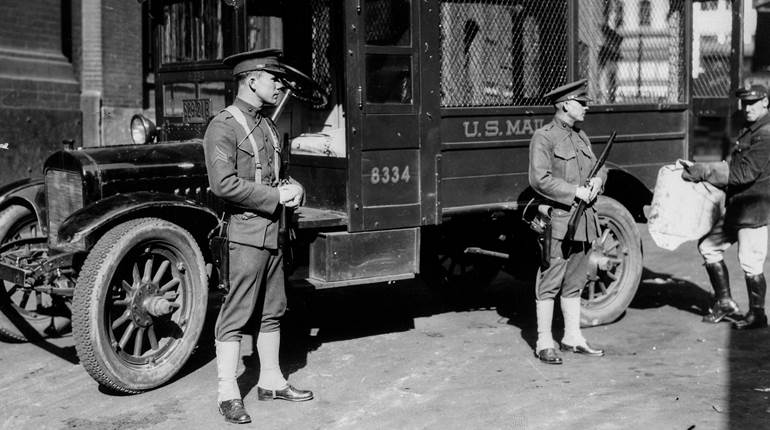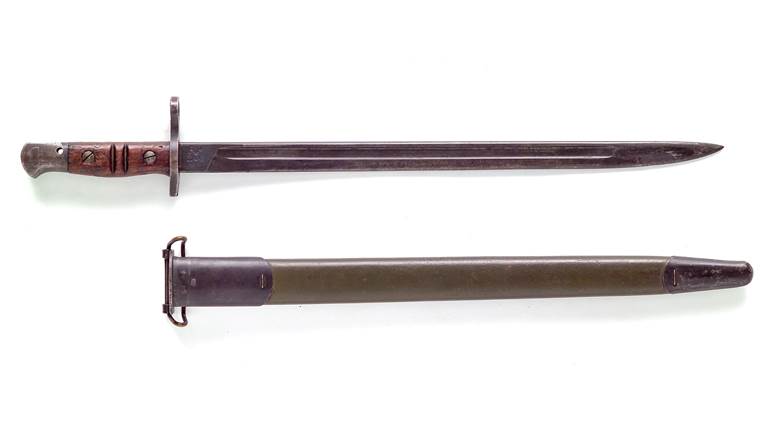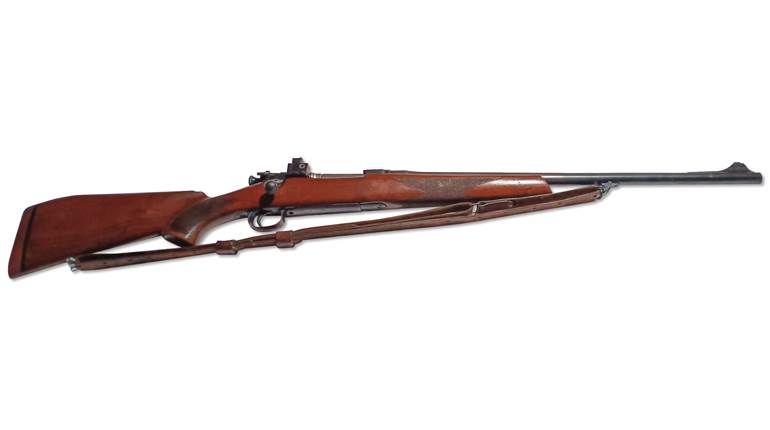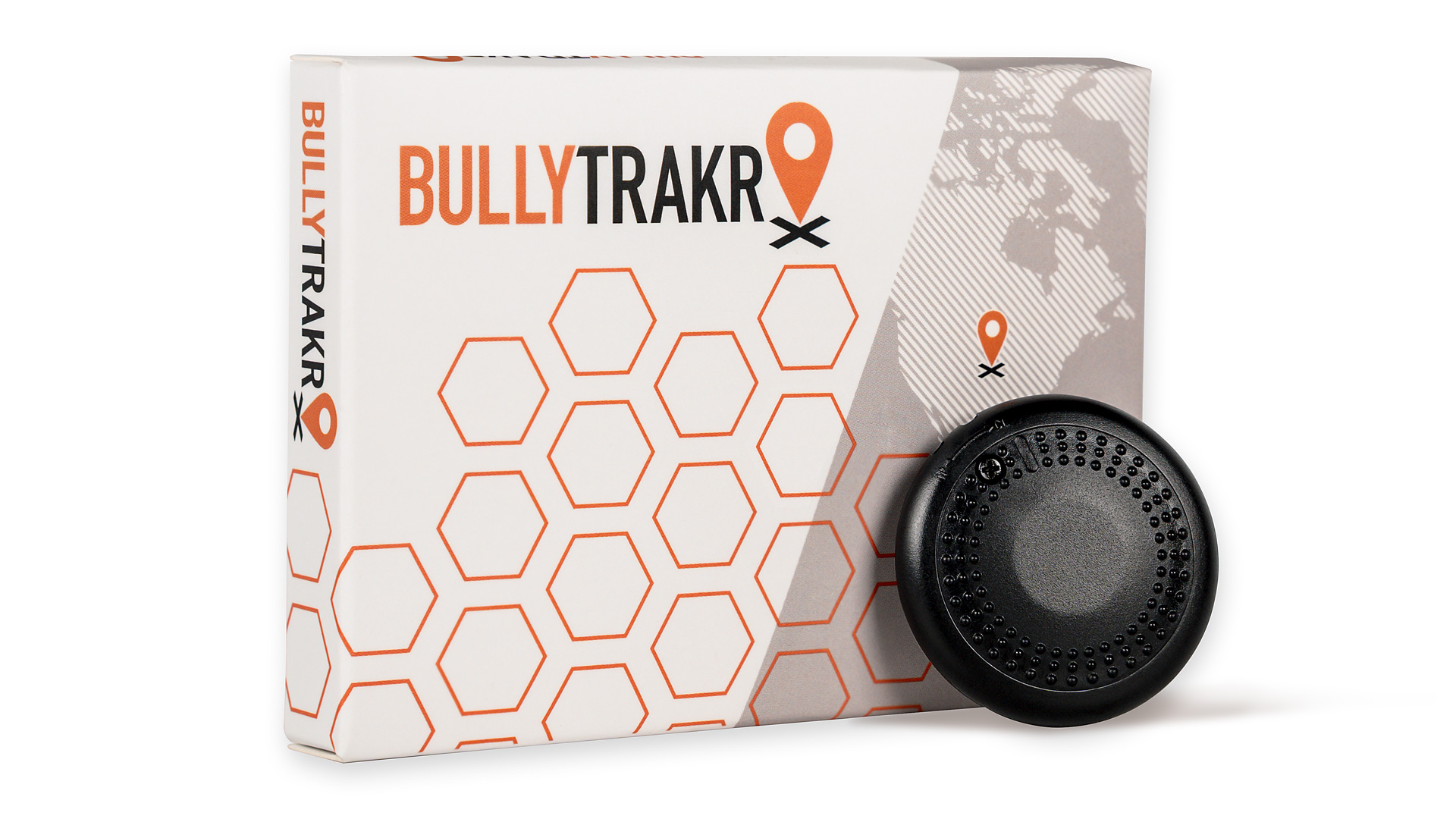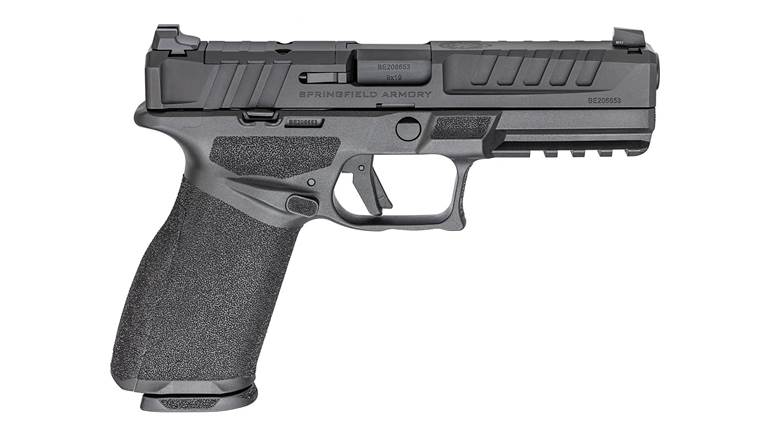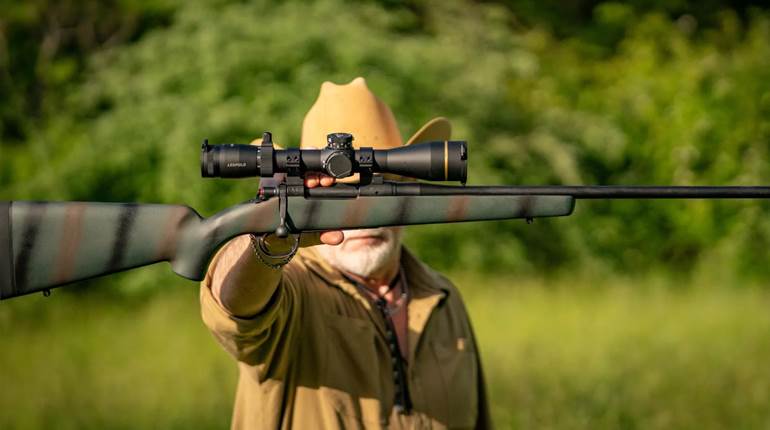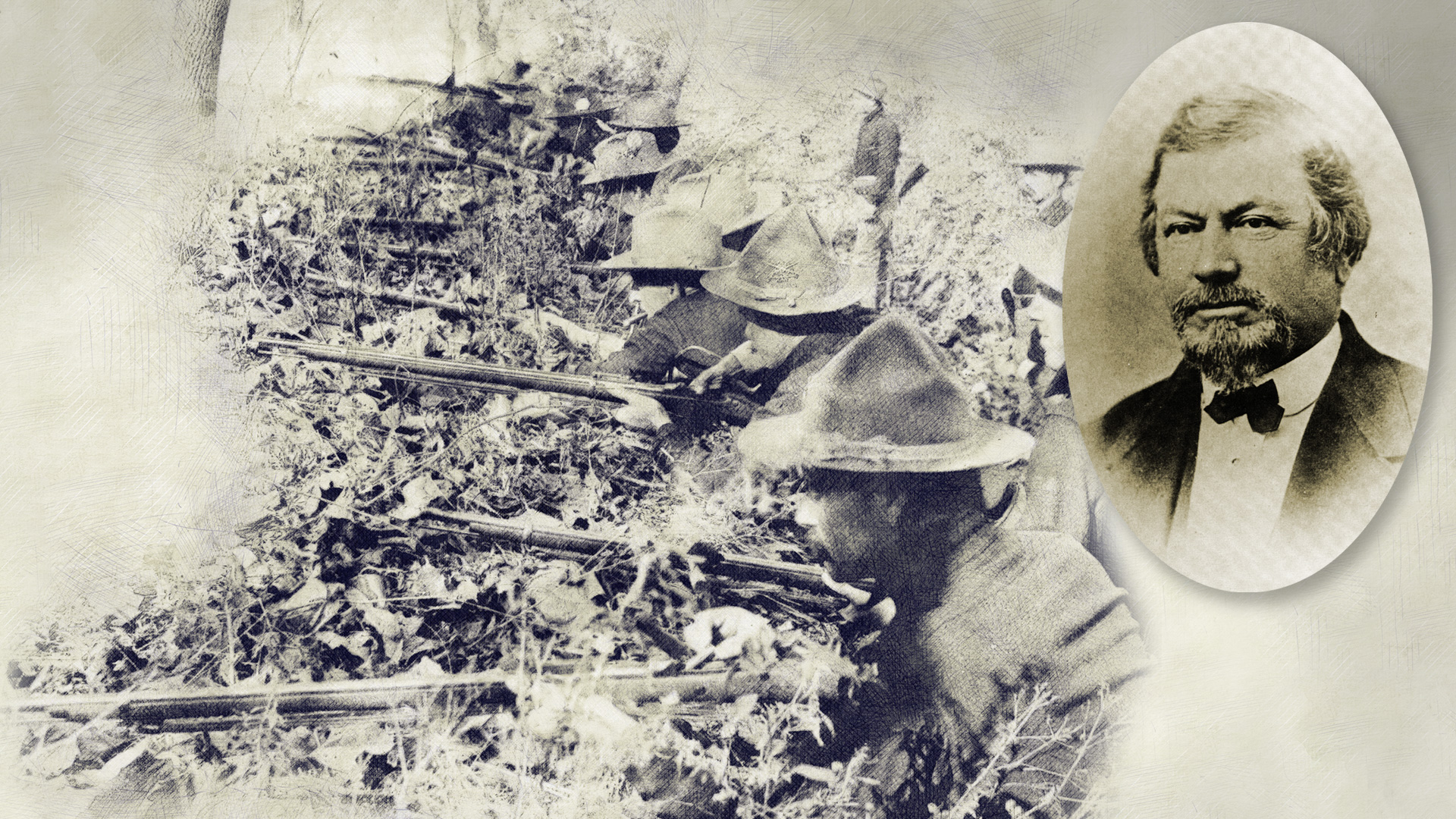
U.S. Army infantrymen (above l.) armed with Trapdoor Springfield rifles fire at Filipino insurgents during the Philippine Insurrection of 1899. Photo courtesy of Tom Laemlein.
The genesis of the Trapdoor Springfield occurred just after the conclusion of the Civil War. Following the events at Appomattox, the Army was rapidly demobilized but was soon tasked with providing protection for the ever-growing numbers of westward-bound settlers. The recently concluded war had proven the worth of breechloading arms, but due to the draconian budgetary cuts that followed, funds were not available to procure new guns for the Army. There were tens of thousands of perfectly serviceable .58-cal. muzzleloading percussion rifle muskets, some never issued, residing in warehouses. Civil War-era breechloading carbines, such as the Spencer and Sharps, were issued to some cavalry units but were little more than a stopgap measure and did nothing to equip the infantry with breechloaders.
In 1865, the master armorer of Springfield Armory, Erskine S. Allin, devised an ingenious solution to the problem. His method was to convert the obsolete muzzleloading muskets into breechloaders by milling away a portion of the top rear of the barrel and attaching a hinged breechblock containing a firing pin and an extractor/ejector mechanism. Similar hinged-breechblock mechanisms had been fabricated by foreign and domestic gunmakers with varying degrees of success. Allin’s design was soon given the unofficial, but widely used, descriptive nickname “Trapdoor Springfield.”

The Model 1865 rifle (top) initiated Erskine Allin's innovative hinged-breechblock (inset) concept. Photo courtesy of Rock Island Auctions.
Model 1865
The first pattern, the Model 1865, was dubbed the “First Allin Conversion.” Five thousand Model 1861 .58-cal. breechloading rifle muskets were converted using Allin’s design. The guns retained their original 40" barrels and were chambered for a .58-cal. rimfire metallic cartridge but were otherwise essentially unchanged from the original Civil War muzzleloaders. The modified rifle was issued with the standard Model 1855 triangular socket bayonet.

Inset photo, shown with breechblock hinged open, courtesy of National Firearms Museum.
Model 1866
The breechblock mechanism and rimfire cartridge of the Model 1865 proved to be less than satisfactory, and the Model 1866 (“Second Allin Conversion”) was developed and adopted. The new variant retained the original 40" barrel, but it was reamed out and a .50-cal. sleeve brazed in place to accommodate a new cartridge. The somewhat complicated “First Allin” breechblock was replaced by a simpler and stronger breechblock assembly. A much-improved .50-cal. centerfire cartridge, the “.50-70 Government,” was developed for the new design. Some 25,000 Model 1863 muzzleloading rifle muskets were converted to the Model 1866 configuration, but other than the sleeved barrel and hinged breechblock, it remained in the same configuration as the Model 1863 muskets. There were 424 Model 1866 “Cadet Rifles" produced as well. The Model 1855 socket bayonet continued to be issued with the Model 1866 and subsequent .50-70 Gov’t-chambered Trapdoor Springfield rifles.

Images courtesy of National Firearms Museum.
Model 1868
The Model 1866 was followed by the Model 1868, which was chambered for the same .50-70 Gov’t cartridge but featured a newly made receiver and was fitted with a barrel sleeved to .50 caliber and shortened to 32½". More than 50,000 (52,145) Model 1868 rifles were produced between 1868 and 1872. There were also 3,401 Cadet models (designated “Model 1869”) produced. Civil War-era lockplates (usually dated 1863 or 1864) were used, and the breechblocks were dated “1869” or “1870.” Four Model 1868 carbines were fabricated but never issued.

Model 1870
The final variant of the .50-70 Gov’t Trapdoor Springfield was the Model 1870. It was very similar to the previous .50-70 Model 1868 but had a shorter receiver and newly made .50-cal., 321/2" barrel. Civil War-era lockplates and other furniture continued to be used. Breechblocks were marked either “1870” or “Model 1870.” A total of 11,531 Model 1870 rifles were manufactured between 1870 and 1873. In addition to the rifle version, 362 Model 1870 carbines were produced between April and December 1871. These had 22" barrels and were fitted with a “swivel bar and ring” assembly for cavalry use. The Model 1870 rifle and carbine are noteworthy, as they were essentially the prototypes for the widely produced and issued “Trapdoor Springfield,” the .45-70 Gov’t Model 1873 and later variants.

Note the “thin wrist” section (arrow) on the Model 1873 stock that proved to be prone to breakage.

Model 1873
The Model 1870 rifle and carbine proved to be improvements over the previous “Trapdoor Springfield” models, but the .50-70 Gov’t cartridge was found to be less than optimal. A trial was held in 1872 to determine what rifle and carbine would be standardized to equip the U.S. Army infantry and cavalry units. In 1873, slightly modified versions of the Model 1870 rifle and carbine, chambered for the newly developed “.45-70 Government” cartridge, which was ballistically superior to the .50-70 Gov’t, was approved for adoption. The .45-70 Gov’t cartridge was loaded with 70 grains of blackpowder and a 405-grain lead bullet. A cartridge was developed for the carbine that used the same 405-grain bullet but had only 55 grains of powder to reduce recoil.
The newly adopted arms had a blued finish rather than the “National Armory Bright” finish of the previous Trapdoor Springfields. The Model 1873 bayonet was adopted concurrent with the Model 1873 rifle. Model 1873 bayonets were fabricated from the sizeable supply of Model 1855 bayonets left over from the Civil War. Their sockets were “bushed down” by means of a “cold-pressing” process developed by Springfield Armory so the bayonets could be used with the smaller-diameter .45-70-chambered barrels, and the formerly bright-finished bayonets were blued.
The Model 1873 rifles and carbines had breechblocks marked “U.S. Model 1873” with “U.S. Springfield” above “1873” adjacent to a “spread eagle” insignia on the sideplate. The stock had a “short comb/thin wrist” configuration and utilized the same pattern of solid buttplate as the previous Trapdoor Springfield models. Model 1873 stocks were marked with an “ESA” (Erskine S. Allin) inspection stamp.
 The rear sight was adjustable for elevation but not windage. The carbine had the same type of “swivel bar and ring” assembly as the Model 1870 carbine. The Model 1873 carbine barrel band had a stacking swivel. A total of 216,230 Model 1873 rifles and 20,028 Model 1873 carbines were produced, along with 8,588 Model 1873 Cadet Rifles (used at West Point and other military schools).
The rear sight was adjustable for elevation but not windage. The carbine had the same type of “swivel bar and ring” assembly as the Model 1870 carbine. The Model 1873 carbine barrel band had a stacking swivel. A total of 216,230 Model 1873 rifles and 20,028 Model 1873 carbines were produced, along with 8,588 Model 1873 Cadet Rifles (used at West Point and other military schools).
The Model 1873 carbine featured (inset) a “swivel bar and ring” attachment (inset). Courtesy of International Military Antiques.
The first Model 1873 carbines were shipped from Springfield between December 1873 and January 1874 for subsequent distribution to several western Army posts. One of the units to receive Model 1873 carbines was the 7th Cavalry commanded by Lt. Col. George A. Custer. There had been some issues previously encountered with the new carbines which were tragically, but vividly, illustrated on June 25, 1876, at the infamous Battle of Little Bighorn. Among the problems was the fact that the ammunition cases were found to be too soft and could sometimes become stuck in the chamber. Unlike the rifle, which was fitted with a full-length cleaning rod under the barrel, the carbine’s lack of a cleaning rod and broken shell extractor to clear jammed cartridges proved to be a serious hindrance. Also, the “thin wrist” stock was the cause of numerous breakages.

Note the Model 1877 carbine’s change in stock configuration to incorporate a thicker wrist (top) to reduce breakage and a butt trap that held, among other things, a headless shell extractor (above, inset). Courtesy of Rock Island Auction.
Model 1877
The problem with the defective cartridges was addressed by improved ammunition. The breakage-prone stock was re-designed to incorporate a thicker wrist for greater strength. A butt trap recess was routed into the buttstock to accommodate a three-piece jointed cleaning rod for the carbine and other tools; it could be accessed via a buttplate with a hinged door. The revised pattern was designated as the “Model 1877,” but the breechblocks retained the “1873” marking. The rear sights were stamped “R” or “C” to denote “rifle” or “carbine,” a practice that was continued on subsequent models. Interestingly, after 1877, the infantry rifles and Cadet Rifles retained the “Model 1873” nomenclature and only the carbine was officially re-designated as the “Model 1877,” with some 19,881 carbines of that pattern being produced from 1877 to 1884. Most of the earlier Model 1873 rifles, carbines and Cadet Rifles were subsequently modified to incorporate the 1877 features.

In 1879, several minor changes, including the introduction of the "Buckhorn" sight, were made to the Trapdoor Springfield design, although there was no change in the official designation.
1879 Changes
Although the basic design remained the same, several relatively minor changes were subsequently made during the intervening years, most notably the introduction of the “Model 1879 Buckhorn” rear sight. The configuration of the breechblock was slightly changed but continued to be marked “1873,” however, the “1873” date was deleted from the lockplate. The inspection stamp on the stock was changed from “ESA” to “SWP” to denote master mechanic and inspector, Samuel W. Porter, who succeeded Erskine Allin. Some collectors classify these variants as the “Model 1879,” but there was not an official change in the model designation.

Model 1884
In 1884, the Model 1884 “Buffington” rear sight was developed for use with the Trapdoor Springfield rifle, carbine and Cadet Rifle. Unlike the earlier rear sights, which were only adjustable for elevation, the new sight was fully adjustable for windage as well. Otherwise, there were no significant changes made, but the new version was designated as the “Model 1884,” and the breechblock markings were changed accordingly. Roughly 20,000 (20,003) Model 1884 carbines were made, along with 148,796 rifles and 13,500 Cadet Rifles. Production ceased in 1893. A Model 1884 Trapdoor Springfield rifle (top) is shown next to the more compact carbine version. U.S. Army Indian Scouts, here armed with Trapdoor Springfield carbines, served from 1866 to 1914. Image courtesy of National Archives.
A Model 1884 Trapdoor Springfield rifle (top) is shown next to the more compact carbine version. U.S. Army Indian Scouts, here armed with Trapdoor Springfield carbines, served from 1866 to 1914. Image courtesy of National Archives.

Variants
In addition to the standardized rifle, carbine and cadet versions, there were a number of other variants of the Trapdoor Springfield produced. These included:

National Firearms Museum
Officer’s Model
These beautiful, virtually handmade rifles were markedly different from standard-issue arms and had special stocks, sights, checkering and engraving. These were for private purchase by Army officers and not issued to troops. In all, 477 examples were made by Springfield Armory from 1875 to 1885.
 Model 1888 Trapdoor rifle with rod bayonet extended (top) shown with a close view of Model 1880 rod bayonet (bottom) in retracted position (inset). Courtesy of Rock Island Auction Co. & National Firearms Museum.
Model 1888 Trapdoor rifle with rod bayonet extended (top) shown with a close view of Model 1880 rod bayonet (bottom) in retracted position (inset). Courtesy of Rock Island Auction Co. & National Firearms Museum.
Rod Bayonet Rifles
Several types of rifles fitted with sliding “rod bayonets” were produced including the Models 1880, 1884 and 1888. Each model featured a different rod bayonet design. Although fairly sizeable numbers of these rifles were produced between 1880 and 1893, they saw less use than the standard rifles but are very interesting arms.
 Model 1881 Trapdoor “Forager” 20-gauge shotgun. Courtesy of Author's collection.
Model 1881 Trapdoor “Forager” 20-gauge shotgun. Courtesy of Author's collection.
Model 1881 Forager
Some 1,376 20-ga. shotguns based on the Trapdoor Springfield were manufactured between 1880 and 1885 and dubbed the “Forager.” As the name suggests, these guns were made for hunting use to provide fresh meat for troops in the field and were not intended for combat purposes.
1886 Experimental Trapdoor Carbine
In 1886, a carbine version with a 24" barrel was developed that featured an almost-full-length stock. Some 1,000 were produced, and varying numbers were issued to several cavalry troops in the West. However, it offered no real advantage over the standard carbine and was not adopted as standard.
 Model 1886 Trapdoor experimental full-stock carbine. Courtesy of author’s collection.
Model 1886 Trapdoor experimental full-stock carbine. Courtesy of author’s collection.
Other variants made in limited numbers included several types of shortened rifles, a special “Marksman” rifle, target rifles and a “long range” rifle. Also, a few rifles chambered for an experimental .30-cal. cartridge were fabricated for testing.
 Standard manual for the Trapdoor weapons titled “Description and Rules for the Management of Springfield Rifle, Carbine and Army Revolver, Calibre .45” This original copy is dated 1874. Courtesy of author’s collection.
Standard manual for the Trapdoor weapons titled “Description and Rules for the Management of Springfield Rifle, Carbine and Army Revolver, Calibre .45” This original copy is dated 1874. Courtesy of author’s collection.
Trapdoor Springfields were the standard longarms for U.S. Army infantry and cavalry units engaged in the “Indian Wars” from the early 1870s to the mid-1890s and were also issued to Navy and Marine Corps units.
 1889 U.S. Army Rifle Team with their Trapdoor Springfield Rifles. Courtesy of National Archives.
1889 U.S. Army Rifle Team with their Trapdoor Springfield Rifles. Courtesy of National Archives.
Conclusion
The Trapdoor Springfield was in production from 1873 through 1893. It was superseded by the repeating bolt-action Model 1892 Krag-Jørgensen, which went into production at Springfield Armory in 1894 and was chambered for the .30-40 smokeless-powder cartridge known today as the .30-40 Krag.
 New York National Guard cavalry troopers with .45-70 Trapdoor Springfield carbines, date unknown. Courtesy of Tom Laemlein.
New York National Guard cavalry troopers with .45-70 Trapdoor Springfield carbines, date unknown. Courtesy of Tom Laemlein.
Even after being supplanted by the Krag, however, the obsolescent-but-still-dependable Trapdoor Springfield was not yet ready to be put out to pasture. With the declaration of war against Spain in 1898, the Krag was the standard United States service rifle but was in critically short supply. Fortunately, there were still significant numbers of .45-70 Gov’t Trapdoor Springfields on hand, and most of the U.S. Army volunteer units were armed with Trapdoors. When the United States became embroiled in the Philippines shortly after the conclusion of the Spanish-American War, many American soldiers were also armed with Trapdoor Springfields.
 U.S. Army infantrymen with Trapdoor Springfield rifles with fixed bayonets practicing a “defensive line” formation, 1898. Courtesy of Tom Laemlein.
U.S. Army infantrymen with Trapdoor Springfield rifles with fixed bayonets practicing a “defensive line” formation, 1898. Courtesy of Tom Laemlein.
Undoubtedly, most of the soldiers would have preferred to have had the repeating Krag bolt-actions instead of the single-shot .45-70s, but it was better than the alternative, which likely would have been nothing. Most of the Trapdoors were purged from the American military inventory by the first decade of the 20th century, but as late as World War I, some Trapdoors were seen in the hands of volunteers stateside guarding bridges and other vital areas. Some National Guard troops were reportedly armed with Trapdoor rifles during some of the labor unrest of the 1920s.
 1st Illinois Volunteer infantry with Trapdoor Springfield rifles and bayonets, Spanish-American War. Courtesy of Tom Laemlein.
1st Illinois Volunteer infantry with Trapdoor Springfield rifles and bayonets, Spanish-American War. Courtesy of Tom Laemlein.
Although it was eventually rendered obsolete by smokeless powder and smaller-caliber, repeating bolt-action rifles, the venerable Trapdoor Springfield served as a standard U.S. military arm for almost three decades. It is a popular martial collectible today and exhibits the flawless craftsmanship found on all the arms manufactured by Springfield Armory. Its legacy as a quintessential part of America’s military history is secure even a century and a half later.












